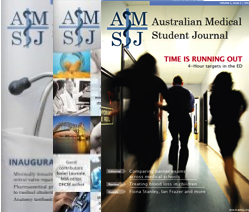MBBS, University of Western Sydney
Intern, Gosford Hospital
Breast cancer is common. One in eight Australian women will be diagnosed by the time they turn 85, and it has been estimated that this year in Australia approximately 14,600 women will receive the diagnosis, around 40 women each day. [1] A significant proportion will undergo surgery, mostly as the first means of treatment. Over the past forty years many advances have been made in the surgical approach to breast cancer. [2] New techniques and approaches have been developed and efforts for further improvements are ongoing. This article will explore the journey that breast surgery has undergone and what we can learn from its evolution.
William Halsted (born 1852) was an American surgeon whose contributions have influenced surgical principles to this day. [3] He is considered one of the ‘Big Four’ founding physicians of John Hopkins Hospital. [4] He pioneered the use of the hospital chart, advocated careful handling of tissue during surgery and stressed the importance of haemostasis. [3-6] His name is also synonymous with the radical mastectomy that he introduced in 1882. [3] At that time attempts at breast surgery had resulted in poor long term results and prognosis. [6,7] This new surgical approach was revolutionary in the treatment of breast cancer. The radical mastectomy was implemented for breast cancer no matter the size of the tumour, type, or the patient’s age. [8] It typically involves removal of all breast tissue, axillary lymph nodes and both pectoralis muscles. [6] It often results not only in severe disfigurement of the patient but also weakened arm function and disabling lymphoedema. [9] Whilst revolutionary at the time it was pioneered by Halsted, it was still widely used in the 1970s with a ‘one size fits all’ approach. [8] That approach is very different to the one taken today. [2,10,11]
While there had been some exploration of modifications to the procedure, such as sparing of the pectoralis muscles, as well as further dissection with removal of the internal mammary nodes, the surgical approach to breast cancer remained relatively static for more than eighty years. [8] Although there are many potential reasons this state of inactivity is surely multifactorial. Feminist authors have claimed that the mastectomy was not altered by male surgeons because of the power and control it gave them; that they had no understanding of the importance of a woman’s breast to a woman and treated patients in response to this view. [12] Others have suggested that Halsted was held in such high regard that no one dared alter his procedure, with surgeons ‘indoctrinated’ into his way of thinking. [12,13] Perhaps it is also that the nature of the disease affected how it was approached, with surgeons hesitant to make changes to a procedure they believed could save the lives of countless women. This seemed to be the case for Halsted himself who suggested, “After all, disability, ever so great, is a matter of very little importance as compared with the life of the patient.” [6] It must be acknowledged that in Halsted’s time there was no method of grading or staging cancers as there is now, a problem he recognised stating, “the importance of such a classification, if it were to any extent possible, is so evident that it is unnecessary to emphasize it.” [7] Had he had such information available to him his approach to individual cases may have varied greatly.
Alterations to the mastectomy were taken cautiously. There were forays into and case reports of the super-radical mastectomy, simple mastectomy and use of radiation therapy, as well as some use of simple excision; however no clear evidence as to the differences was available. [8] In 1969 the World Health Organisation approved a randomised control trial comparing radical mastectomy to the ‘quadrantectomy’. [8] Recruitment began in 1973 of patients staged with T1N0 disease who were aged less than 70 years. The quandrantectomy was combined with complete axillary dissection and postoperative radiotherapy. Early data demonstrated no difference in regards to survival rates, and the similarities in the long term survival rates were confirmed in data released in 2002. [8] In 1971 Fisher et al commenced a randomised trial comparing the radical mastectomy with total mastectomy with or without radiotherapy. [14] Studies such as these heralded the advent of breast conserving surgery and the acknowledgement that routine radical mastectomy may not always be the most appropriate surgical management.
Halsted proposed that although breast cancer begins as a local disease, it spreads in a contiguous manner away from the primary site through the lymphatic system. [6,15] This proposal led to his emphasis on aggressive locoregional treatment to prevent further spread. [6,7,12,15] This principle, however (known as the ‘Halsted Theory’), was also critical in introducing the concept of a sentinel node in relation to breast cancer. [15] Research into the sentinel node led to the use of the sentinel node biopsy which has dramatically influenced surgical management and outcomes for patients. One of the first studies demonstrating the benefits of lymphatic mapping for breast cancer was published by Guiliano et al in 1994. [16] Since that time the evidence, understanding and surgical skills in this area have grown rapidly.
Modern day surgery for breast cancer has changed significantly compared to that performed in the 1970s. The combination of breast conserving surgery alongside a sentinel biopsy allows patients to be left with good cosmetic results. [17,18] Oncoplastic techniques such as remodelling mammoplasty are also being utilised to improve cosmetic outcomes without compromising adequate tumour removal. [19,20] There is still however an appropriate place for the mastectomy. [20] Breast conservation is desirable, but needs to be acceptable cosmetically and not result in compromise to local control of the disease or survival benefit. [17,19,20] If local recurrence does occur following breast conservation, then salvage mastectomy is considered the standard approach, with salvage breast-conserving surgery only currently appropriate for consideration in select patients. [21]
Reconstructive breast surgery is an important part of management utilised by surgeons today. It is significant in improving the psychological morbidity associated with breast cancer surgery, particularly following mastectomy. [2,22] Once again Halsted had an influence in this area of breast surgery. He believed reconstruction was a “violation of the local control of the disease”. [10] Although there were a few early attempts at breast reconstruction by the likes of Czerny, Tanzini and Ombredanne, [23-25] the opinion put forward by Halsted and the view that local recurrence may not be detected if reconstruction occurred caused it to be avoided. [2,10] It seems, however, that surgical exploration of reconstructive procedures during this period was considered more than the possibility of breast conservation was. [8,10] This supports the view that surgeons at the time believed the mastectomy was crucial to life saving treatment and it was this belief that prevented progress to other initial surgical approaches. [13]
Following the introduction of the mastectomy in 1882 there were surgeons willing to attempt reconstructions to improve the quality of life of their patients. [2,10,22] In 1963 these efforts were bolstered by the silicone gel breast implant introduced by Cronin and Gerow. [26] In 1971 Snyderman and Guthrie placed an implant under the chest wall immediately following a mastectomy, as opposed to the delayed technique that had been used, and this was then accepted as the new technique. [27] In 1982 Radovan introduced the concept of skin expanders for those with significant skin deficits so that these patients too could be eligible for reconstructive surgery. [28] Following this skin-sparing mastectomies were introduced, with results demonstrating similar rates of local recurrence. [29] There have also been advances with the use of flaps as a method of reconstruction. [2,10] In regards to reconstruction of the nipple-areola complex, tattooing is now commonplace as initially suggested by Becker in 1986. [30] Today a woman who thirty years ago would have been left with almost no chance of reconstruction can have a relatively symmetrical result. Decisions relating to the method of reconstruction depend on many variables, however it can be seen that important progress has been made in this area of breast surgery. [2,10] This can improve patient perceptions towards treatment and significantly improve their quality of life. [2,22]
The evolution of breast cancer surgery demonstrates important principles when evaluating any surgical procedure. No matter what procedure is undertaken, the most appropriate management needs to be carefully considered with clear clinical reasoning and evidence where available. Despite this there are also many elements which need to be considered when deciding what is most suitable, not all of which are clear without a thorough understanding of both the patient being treated and the disease. The disease cannot be treated in isolation but must be regarded in consideration of the patient’s wishes, and often in regards to other health issues. This is especially true in oncological surgery. Treatment decisions cannot often be made simply or alone. They are best made by the patient and the surgeon as part of a multidisciplinary team. [2,22] With regard to breast cancer the tumour itself plays a critical role – its type, size, determination of its spread to lymph nodes or metastatic sites, and whether it is hormonally responsive. [2,22] The size of the tumour is crucial in determining operability, especially alongside a consideration of the size of the breast itself. Tumour size, breast size and the location are important when assessing for the likelihood of future local recurrence as well as the impact on cosmetic outcomes. [2,11,17]
For the appropriate management to be undertaken the surgeon must obtain as much information as possible. The patient’s family history and potential for a recognisable genetic factor requires thought. [11] Genetics play an increasingly important role in the management of patients with breast cancer. Along with the well-known BRCA1 and BRCA2 mutations, there are other unidentified genes which lead to strong familial associations. [31] Knowledge of these factors impacts on decisions regarding the surgical management of a particular patient as well as other forms of treatment.
Cost and availability of treatment options are also important in the surgical management of breast cancer. Cost is not often seen to impact on the treatment patients receive in Australia, however it can be overlooked, as can the availability of services and travel required to undergo particular surgical options. [2] These factors are much more pronounced in other parts of the world where only the exceptionally wealthy may be eligible for surgery. [32] It is important to consider the impact of a particular surgical treatment on the need for ongoing follow up and the level to which this will be required. [2,11] No matter which surgical approach is taken it is vital that realistic expectations of the prognostic as well as cosmetic results are discussed with each patient prior to surgery.
Surgical excision deals with local, known disease and comes alongside radiotherapy, chemotherapy, hormonal therapy and biological agents where appropriate. [11,22] These other treatment modalities impact on both prognosis and cosmetic results. [2,11,17,18,22] The role of surgery must be considered in relation to these other factors. Management options for breast cancer will continue to expand in coming years as current therapies improve and new ones emerge, requiring ongoing collaboration. [33]
At a multidisciplinary team (MDT) meeting the many stakeholders involved in a patient’s treatment come together. [11,22] No matter which path is chosen for each area of management, it is done in consultation with other experts, with each responsible for justifying their position. [33] Communication barriers are broken down and the full clinical picture is able to be understood by all involved. Although there is variation worldwide as to how MDTs are run, it is perceived that they improve clinical decision making, treatment quality and the practice of evidence based medicine. [33] Interestingly, Halsted himself viewed it as important that the surgeon had an intimate awareness of the pathology which he excised, writing
“There is a gap between the surgeon and pathologist which can be filled only by the surgeon. The pathologist seldom has the opportunity to see diseased conditions as the surgeon sees them. A tumor on a plate and a tumor in the breast of a patient, how different!” [7]
Halsted seemed to advocate that the surgeon’s interest and understanding of the pathology was more significant than that of the pathologist. The recognition of multi-disciplinary meetings is that all parties have significant “incentive” (as Halsted put it), [7] and by working together the gaps between the theatres, the laboratory and the chemotherapy centre can be closed.
The radical mastectomy is now famous for its brutality. [12] Despite its poor reputation today, by bringing it into existence Halsted caused many women’s lives to be saved. We should respect those who have gone before us and learn from their work, whilst at the same time be willing to question and improve upon it. We need to guard ourselves from repeating mindlessly that which we have been taught, without seeking to develop it. Much has changed since Halsted boldly stated, “Tumours should never be harpooned, nor should pieces ever be excised from malignant tumors for diagnostic purposes.” [7] This may seem strange considering how we now utilise biopsies, although in years to come the flaws in our own thoughts and practices will be exposed.
Halsted was innovative, bringing discoveries to his time, and he will always hold an important role in surgical history. The French philosopher Gaston Bachelard displayed wisdom in saying “the characteristic of scientific progress is our knowing that we did not know”. It should be added that scientific progress comes through our knowing there is much we still do not know, and it is up to us to seek the answers.
Conflict of interest
None declared.
Correspondence
R Young: rebeccayoung07@gmail.com
References
[1] Cancer Australia. Report to the nation – breast cancer 2012. Surry Hills, New South Wales: Cancer Australia; 2012.
[2] Penninton D. Breast reconstruction after mastectomy: current state of the art [Review]. ANZ J Surg. 2005;75(6):454-8.
[3] Rankin J. William Stewart Halsted: a lecture by Dr Peter D. Olch. Ann Surg. 2006;243(3): 418-25.
[4] Roberts C. H.L Mencken and the four doctors: Osler, Halsted, Welch, and Kelly. Proc Bayl Univ Med Cent. 2010;23(4):377-88.
[5] Lathan S. Dr Halsted at Hopkins and at High Hampton. Proc Bayl Univ Med Cent. 2010;23(1):33-7.
[6] Halsted W. The results of operations for the care of cancer of the breast performed at the Johns Hopkins hospital from June, 1889, to January, 1894. Ann Surg. 1894;20(5):497-555.
[7] Halsted W. I. A clinical and histological study of certain adenocarcinomata of the breast: and a brief consideration of the supraclavicular operation and of the results of operations for cancer of the breast from 1889 to 1898 at the Johns Hopkins Hospital. Ann Surg. 1898;28(5):557-76.
[8] Veronesi M, Cascinelli N, Mariani L, Greco M, Saccozzi R, Lunini A et al. Twenty-year follow-up of a randomized study comparing breast-conserving surgery with radical mastectomy for early breast cancer. N Engl J Med. 2002;347:1227-32.
[9] Feigenberg Z, Zer M, Dintsman M. Comparison of postoperative complications following radical and modified radical mastectomy. World J Surg. 1977; 1(2): 207-10.
[10] Uroskie T, Colen L. History of breast reconstruction. Semin Plast Surg. 2004;18(2):65-9.
[11] Association of Breast Surgery at BASO BAPRAS and the Training Interface Group in Breast Surgery. Oncoplastic breast surgery – a guide to good practice. EJSO. 2007;33:S1-23.
[12] Bland C. The Halsted mastectomy: present illness and past history. West J Med. 1981;134(6):549-55.
[13] Veronesi U. Rationale and indications for limited surgery in breast cancer: current data. 1987;11(4):493-8.
[14] Fisher B, Jeong J, Anderson S, Bryant J, Fisher E, Wolmar N. Twenty-five-year follw-up of a randomized trial comparing radical mastectomy, total mastectomy, and total mastectomy followed by irradiation. N Engl J Med. 2002;346:567-75.
[15] Tanis P, Nieweg O, Olmos R, Rutgers E, Kroon B. History of sentinel node and validation of the technique. Breast Cancer Res. 2001;3(2):109-12.
[16] Giuliano A, Kirgan D, Guenther J, Morton D. Lymphatic mapping and sentinel lymphadenectomy for breast cancer. Ann Surg. 1994;220:391-8.
[17] Taylor M, Perez C, Halverson K, Kuske R, Philpott G, Garcia D et al. Factors influencing cosmetic results after conservation therapy for breast cancer. Int J Radiat Oncol Biol Phys. 1995;31(4):753-64.
[18] Rose M, Olivotto I, Cady B, et al. Conservative surgery and radiation therapy for early breast cancer: long-term cosmetic results. Arch Surg. 1989;124(2):153-7.
[19] Clough K, Lewis J, Couturand B, Fitoussi A, Nos C, Falcou M. Oncoplastic techniques allow extensive resections for breast-conserving therapy of breast carcinomas. Ann Surg. 2003;237(1):26-34.
[20] Clough K, Kaufman G, Nos C, Buccimazza I, Sarfati I. Improving breast cancer surgery: a classification and quadrant per quadrant atlas for oncoplastic surgery. Ann Surg. 2010;17(5):1375-91.
[21] Suarez J, Arthur D, Woodward W, Kuerer H. Breast preservation in patients with local recurrence after breast-conserving therapy. Curr Breast Cancer Rep. 2011;3(2):88-96.
[22] Rozen W, Ashton M, Taylor G. Defining the role for autologous breast reconstruction after mastectomy: social and oncologic implications. Clin Breast Cancer. 2008;8(2):134-42.
[23] Czerny V. Plastic replacement of the breast with a lipoma. Chir Kong Verhandl. 1895;2:216.
[24] Tanzini I. Spora il mio nuova processo di amputazione della mammella. Riforma Medica. 1906;22:757.
[25] Teimourian B, Adham M. Louis Ombredanne and the origin of muscle flap use for immediate breast mount reconstruction. Plast Recontr Surg. 1983;72:907-10.
[26] Cronin T, Gerow F. Augmentation mammoplasty: a new “natural feel” prosthesis. Transections of the third international congress of plastic surgery, Amsterdam. Excerpta Medica. 1964;66:41-9.
[27] Snyderman R, Guthrie R. Reconstruction of the female breast following radical mastectomy. Plast Reconstr Surg. 1971;47:565-7.
[28] Radovan C. Breast reconstruction after mastectomy using the temporary expander. Plast Reconstr Surg. 1982:69:195-208.
[29] Lanitis S, Tekkis P, Sgourakis G, Dimopoulos N, Al Mufti R, Hadjiminas D. Comparison of skin-sparing mastectomy versus non-skin-sparing mastectomy for breast cancer: a meta-analysis of observational studies. Ann Surg. 2010;251(4):632-9.
[30] Becker H. Breast reconstruction using an inflatable breast implant with detachable reservoir. Plast Reconst Surg. 1984;73:678-83.
[31] Sotiriou C, Pusztai L. Gene-expression signatures in breast cancer. N Engl J Med. 2009;360:790-800.
[32] Agarwal G, Ramakant P, Forgach E, Rendón J, Chaparro J, Basurto C et al. Breast cancer care in developing countries. World J Surg. 2009;33(10):2069-76.
[33] Saini K, Taylor C, Ramirez A, Palmieri C, Gunnarsson U, Schmoll H et al. Role of the multidisciplinary team in breast cancer management: results from a large international survey involving 39 countries. Ann Onc. 2012;23:853-9.
 Download PDF
Download PDF Read online
Read online You can subscribe by e-mail to receive each issue when it's published.
You can subscribe by e-mail to receive each issue when it's published.
 Download the issue
Download the issue Print this extract
Print this extract Share on Facebook
Share on Facebook


